Pubic hair
| Pubic hair | |
|---|---|
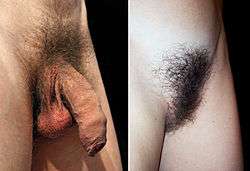 Pubic hair on a mature male (left) and mature female (right) | |
| Details | |
| Identifiers | |
| Latin | pubes |
| TA | A16.0.00.022 |
| FMA | 70754 |
Pubic hair is body hair found in the genital area of adolescent and adult humans, located on and around the sex organs, the crotch, and sometimes at the top of the inside of the thighs, in the pubic region around the pubis bone.
Although fine vellus hair is present in the area in childhood, pubic hair is considered to be the heavier, longer and coarser hair that develops during puberty as an effect of rising levels of androgens in males and estrogens in females. Pubic hair is part of a person's body hair and a secondary sex characteristic. Many cultures regard pubic hair to be erotic, and in most cultures pubic hair is associated with genitalia, which both men and women are expected to keep covered at all times. In some cultures, it is the norm for pubic hair to be removed, especially of females, a practice which is regarded as part of personal hygiene. In other cultures, the exposure of pubic hair (for example, when wearing a swimsuit) may be regarded as unaesthetic or embarrassing, and is therefore trimmed or otherwise styled to avoid it being visible.
Development
The Tanner scale looks at the development of pubic hair. Before the onset of puberty, the genital area of both boys and girls has very fine vellus hair, referred to as Tanner stage 1 hair.[1] As puberty begins, the body produces rising levels of the sex hormones, and in response the skin of the genital area begins to produce thicker and rougher, often curlier, hair with a faster growth rate.[2] The onset of pubic hair development is termed pubarche. The change for each hair follicle is relatively abrupt, but the extent of skin which grows androgenic hair gradually increases over several years.
In males, the first pubic hair appears as a few sparse hairs that are usually thin on the scrotum or at the upper base of the penis (stage 2). Within a year, hairs around the base of the penis are numerous (stage 3). Within 3 to 4 years, hair fills the pubic area (stage 4) and becomes much thicker and darker, and by 5 years extends to the near thighs and upwards on the abdomen toward the umbilicus (stage 5).[3]
Other areas of the skin are similarly, though slightly less, sensitive to androgens and androgenic hair typically appears somewhat later. In rough sequence of sensitivity to androgens and appearance of androgenic hair, are the armpits (axillae), perianal area, upper lip, preauricular areas (sideburns), periareolar areas (nipples), middle of the chest, neck under the chin, remainder of chest and beard area, limbs and shoulders, back, and buttocks.
Although generally considered part of the process of puberty, pubarche is distinct and independent of the process of maturation of the gonads that leads to sexual maturation and fertility. Pubic hair can develop from adrenal androgens alone, and can develop even when the ovaries or testes are defective and nonfunctional. See puberty for details.
There is little if any difference in the capacity of male and female bodies to grow hair in response to androgens. The obvious sex-dimorphic difference in hair distribution in men and women is primarily a result of differences in the levels of androgen reached as maturity occurs.
Pubic hair and axillary (armpit) hair can vary in color considerably from the hair of the scalp. In most people it is darker, although it can also be lighter. In most cases it is most similar in color to the eyebrows of the individual.[4]
Hair texture varies from tightly curled to entirely straight, not necessarily correlating to the texture of the scalp hair.[4][5]
Pubic hair patterns can vary by race and ethnicity.[5] Patterns of pubic hair, known as the escutcheon, vary between sexes. On most women, the pubic patch is triangular and lies over the vulva and mons pubis. On many men, the pubic patch tapers upwards to a line of hair pointing towards the navel (see abdominal hair), roughly a more upward-pointing triangle.[4] As with axillary (armpit) hair, pubic hair is associated with a concentration of sebaceous glands in the area.
Cultural views
Among the upper class in 18th century pre-Victorian Britain, pubic hair from one's lover was frequently collected as a souvenir. The curls were, for instance, worn like cockades in men's hats as potency talismans, or exchanged among lovers as tokens of affection.[6] The museum of St. Andrews University in Scotland has in its collection a snuffbox full of pubic hair of one of King George IV's mistresses, possibly Elizabeth Conyngham, which the notoriously licentious monarch donated to the Fife sex club, The Beggar's Benison.[6]
In Western societies, after the spread of Christianity, public exposure of a woman's bare skin between the ankle and waist started to be disapproved of culturally. Upper body exposure due to the use of the popular vest bodices used in Western Europe from the 15th century to early 20th century, as the widespread dirndls used even in more traditionally conservative mountain areas and the more or less loose shirts under these, enabled a permissive view of the shoulders, décolletage and arms allowing a free exposure of upper body hair in women of all classes with less rejection or discrimination than body hair on the sex organs, obviously to conceal by implication. Many people came to consider public exposure of pubic hair to be embarrassing.[7] It may be regarded as immodest and sometimes as obscene. However, it never came to have a full hold in Western culture in wide tracts of Central Europe, until the encroaching of Protestantism during the 16th century on formerly more tolerant customs.
In Eastern Europe and the Scandinavian North it never caught such restrictions and views on public exposure of pubic hair, as the customs of public bathing and sauna in the nude are clear manifestation of it. With the reintroduction of public beaches and pools bathing in Western Europe and the Mediterranean early in the 20th century, exposure of both sexes' areas near their pubic hair became more common, and after the progressive reduction in the size of female and male swimsuits, especially since the coming into fashion and growth in popularity of the bikini after the 1940s, the practice of shaving or bikini waxing of pubic hair off the hem lines also come into vogue.[7]
In modern times, more after the major international film industry felt under the Code rules and some nations restricting laws, models and actors who appeared nude on stage, film, or photography used to shield their frontal genital area by the angle of their body or leg in relation to the camera, or in some other way; but after the 1960s, it became more common for female adult entertainers and other art performers to appear frontally nude in their artistic work.
Removal
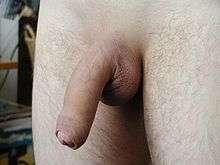
According to the Oxford Companion to the Body, in the 1450s public women would shave their pubic hair for personal hygiene and to combat pubic lice and would then don a merkin or pubic wig where their public line of work would require so.[8][9] In some Middle Eastern societies, removal of female body hair has been considered proper hygiene, mandatated by local customs, for many centuries.[10] Muslim teaching includes Islamic hygienical jurisprudence in which pubic and armpit hair must be pulled out or shaven to be considered as Sunnah. Trimming is taught to be considered acceptable.[11] Evidence of pubic hair removal in ancient India is thought to date back to 4000 to 3000 BC.[12] According to ethnologist F. Fawcett, writing in 1901, he had observed the removal of body hair, including pubic hair about the vulva, as a custom of women from the Hindu Nair caste.[13]
Some strippers and pornographic actresses, who always had inherently performed in the nude with more or less strict regulation laws according to the licenses allowed to their job location, began, some time in the late 1980s after the widespread fear of the HIV/AIDS epidemic and other STDs and contagions, to a more radical trimming of their pubic hair. The spread of contagious diseases at the time was affecting many in the industry, though it was transmitted by body fluids, not hair. Though, one expert maintains that the sole reason for the removal in pornography was a matter of "technical considerations of cinematography".[14] The fashion progressed to the extremes of reducing ever increasing amounts of pubic hair until its full removal.[15] The widespread consuming of porn film and its watching, increased by the parallel boom of domestic video use, would catapult the adoption and mimicking of the concurrent fashion by the general public of women of the time.[16] The fashion of such practices would reach cult status, and the growth of a whole industry dedicated to its maintenance after its implanted social acceptance and even some universal projection, it soon acquired the negative connotations of discrimination to any pubic hair in women (and even on men) in a totalitarian turn of social intolerance.[17] Observation of most pornographic or artistic nude material before that decade and from the advent of the filming or photography camera, would show most if not all the performers or models with their own pubic hair differences of growth, with no signs of invested rejection or manipulated discrimination. The presentation is regarded by some as being erotic and aesthetic, while others consider the style as unnatural. Some people remove pubic hairs for erotic and sexual reasons or because they or their sex partner enjoy the feel of a hairless crotch.[18][19]
Styling
When the hair is waxed, this practice is widely referred to as bikini waxing. The method of removing hair is called depilation (when removing only the hair above the skin) or epilation (when removing the entire hair). Beauty salons often offer various waxing services. It is sometimes referred to as "pubic topiary".[20][21][22]
It is unusual for pubic hair to be dyed or painted, except incidentally to bodypainting. Concerns have been raised about the safety of using regular hair dye for this purpose, but dyes have been formulated for use on pubic hair. This is sometimes done to enable someone to match their pubic hair to the (dyed) hair on their head, or in whimsical colours.[23]
Some people modify their pubic hair—either to fit in with societal trends, or simply as an expression of their own style or lifestyle.[14][17]
-
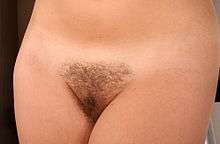
"American wax"—hair limited to the bikini area, and trimmed shorter
-

"French wax"—waxing with a "landing strip"
-
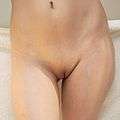
Full Brazilian or "the Sphinx"—a full waxing; no hair at all
These styles include:
- Natural, Au naturel[24]
- No trimming and therefore no maintenance.
- Trimmed or cut
- Hair length is shortened but not removed or shaped, inner thighs may be shaved.
- Triangle
- Hair removed (generally waxed) from the sides to form a triangle so that pubic hair cannot be seen while wearing swimwear. This can range from the very edge of the "bikini line" to up to an inch reduction on either side. Hair length can be from an inch and a half to half an inch.
- Landing strip
- Hair sharply removed from the sides to form a long centered vertical rectangle, hair length about quarter of an inch.
- Brazilian waxing
- Pubic hair completely removed except for a very thin remnant, centered, narrow stripe above the vulva approximately an inch in height, and the hair length in the sub-centimeter range.
- Full-Brazilian, Hollywood, Sphinx
- Pubic hair completely removed.
- V-shaped[25]
- Adaptation of the triangle shape with an inner triangle removed, rarely with a top bar remaining ▽.
- Heart, also diamonds, spades, clubs
- The heart shape is an adaptation of the triangle shape with the top shaped into two half circles. The diamond shape has the upper part of the triangle shape cut into an up-pointing triangle instead.
- Freestyle (flash, star and other symbols, letters)
- These are usually variations of the Brazilian/G-wax, where a design is formed of the pubic hair above completely bare vulva. Stencils for several shapes are available commercially.[26] A controversial Gucci commercial included female pubic hair shaved into a 'G'.[27]
In art
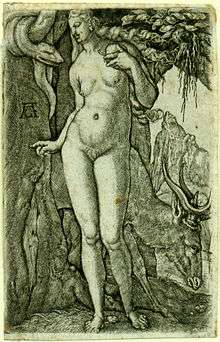
In ancient Egyptian art, female pubic hair is indicated in the form of painted triangles.[28] In medieval and classical European art, pubic hair was very rarely depicted, and male pubic hair was often, but not always, omitted.[29] Sometimes it was portrayed in stylized form, as was the case with Greek graphic art.[30] The same was true in much of Indian art, and in other Eastern portrayals of the nude. In 16th century southern Europe, Michelangelo showed the male David with stylized pubic hair, but female bodies were depicted hairless below the head. Nevertheless, Michelangelo's male nudes on the Sistine Chapel ceiling display no pubic hair. In Renaissance northern Europe, pubic hair was more likely to be portrayed than in the south, more usually male, while occasionally on female figures.
According to John Ruskin's biographer Mary Lutyens, the notable author, artist, and art critic was apparently accustomed only to the hairless nudes portrayed unrealistically in art, never having seen a naked woman before his wedding night. He was allegedly so shocked by his discovery of his wife Effie's pubic hair that he rejected her, and the marriage was later legally annulled. He is supposed to have thought his wife was freakish and deformed.[31] Later writers have often followed Lutyens and repeated this version of events. For example, Gene Weingarten in his book I'm with Stupid (2004) writes that "Ruskin had [the marriage] annulled because he was horrified to behold upon his bride a thatch of hair, rough and wild, similar to a man's. He thought her a monster."[32] However, there is no proof for this, and some disagree. Peter Fuller in his book Theoria: Art and the Absence of Grace writes, "It has been said that he was frightened on the wedding night by the sight of his wife's pubic hair; more probably, he was perturbed by her menstrual blood." Ruskin's biographers Tim Hilton and John Batchelor also believe that menstruation is the more likely explanation.[33]
Francisco Goya's The Nude Maja (1797) has been considered as probably the first European painting to show a female subject's pubic hair, though paintings had hinted at it. The painting was considered quite pornographic at the time.[34] Gustave Courbet's L'Origine du monde (The Origin of the World, 1866) was considered scandalous probably more because of the presentation of thick pubic hair than the exposed female genitals.
In the late 18th century female pubic hair is openly portrayed in Japanese shunga (erotica), especially in the ukiyo-e tradition.[35] Hokusai's picture The Dream of the Fisherman's Wife (1814), which depicts a woman having an erotic fantasy, is a well-known example. In Japanese drawings, such as hentai, pubic hair is often omitted, since for a long time the display of pubic hair was not legal. The interpretation of the law has since changed.[36]
See also
References
- ↑ Green, Morris (1998). Pediatric diagnosis: interpretation of symptoms and signs in children and adolescents. Saunders. p. 200.
- ↑ Rogol, Alan (2002). "Androgens and puberty". Molecular and Cellular Endocrinology. 198 (1), 25–29.
- ↑ Neill, Sallie; Lewis, Fiona (2009). Ridley's the Vulva. John Wiley and Sons. p. 25. ISBN 978-1-4051-6813-7.
- 1 2 3 Sherrow, Victoria (2006). Encyclopedia of hair: a cultural history. Greenwood Publishing Group. p. 315.
- 1 2 Morris, Desmond (2007). "The Pubic Hair". The Naked Woman. pp. 192–202. ISBN 0-09-945358-4. Retrieved 2013-11-03.
- 1 2 Perrottet, Tony (December 14, 2009). "Secrets of the Great British Sex Clubs". Slate Magazine. Retrieved December 15, 2009.
- 1 2 Heinz Tschachler, Maureen Devine, Michael Draxlbauer; The EmBodyment of American Culture; pp. 61–62; LIT Verlag, Berlin-Hamburg-Münster; 2003; ISBN 3-8258-6762-5.
- ↑ Oxford Companion to the Body, Oxford University Press, 2002.
- ↑ Francis, Gareth (June 26, 2003). "A short and curly history of the merkin". The Guardian.
- ↑ Kutty, Ahmad (13/Sep/2005) Islamic Ruling on Waxing Unwanted Hair Archived March 2, 2010, at the Wayback Machine. Retrieved March 29, 2006
- ↑ Ismail, Buyukcelebi (2003). Living in the Shade of Islam: A Comprehensive Reference of Theory and Practice. Tughra Books. p. 169. ISBN 1-932-09921-2.
- ↑ April Masini, Think & Date Like a Man, 2005, page 49, ISBN 0-595-37466-2, Date Out of Your League, 2004, ISBN 0-9746763-0-6
- ↑ F. Fawcett (2004) [1901]. Nâyars of Malabar. Asian Educational Services. p. 195. ISBN 978-81-206-0171-0. Retrieved 23 June 2011.
- 1 2 "Pubic hair is back". The Daily Telegraph.
- ↑ Friedland, Roger (13 June 2013). "Looking Through the Bushes: The Disappearance of Pubic Hair". The Huffington Post.
- ↑ Hsu, Christine (28 November 2012). "French Study Reveals Why an Increasing Number of Women Are Tuning in to Porn". Medical Daily.
- 1 2 Shire, Emily (4 October 2014). "Waxing: Damned if You Do and Damned if You Don't: How Pubic Hair Became Political". The Daily Beast.
- ↑ The Hair Down There. University of California, Santa Barbara's SexInfo. Retrieved May 4, 2007.
- ↑ Rowen, Tami S.; Gaither, Thomas W.; Awad, Mohannad A.; Osterberg, E. Charles; Shindel, Alan W.; Breyer, Benjamin N. (2016). "Pubic Hair Grooming Prevalence and Motivation Among Women in the United States". JAMA Dermatology. doi:10.1001/jamadermatol.2016.2154. ISSN 2168-6068.
- ↑ The Fuzz That Was. Willamette Week.
- ↑ Belle de Jour's naughty notebook. The Telegraph.
- ↑ Pubic-Hair Topiary. The Stranger.
- ↑ "Pubic Hair Dye: Betty Beauty". Retrieved July 25, 2008.
- ↑ Germinsky, Lisa (December 11, 2008). Bush is back. Salon.com.
- ↑ "MetArt Fine Photography". Retrieved September 12, 2008. (NSFW)
- ↑ e.g. from "Newf".
- ↑ "tom's pubic ad avoids ban". Vogue. February 27, 2003. Retrieved October 27, 2008.
- ↑ Stuckey, Johanna (2007). The "Holy One". Cross Quarterly for the Goddess Woman. 6 (4).
- ↑ Barcan, Ruth (2004). Nudity: a cultural anatomy. Berg. p. 144. ISBN 978-1-85973-872-6.
- ↑ Hollander, Anne (1993). Seeing through clothes. University of California Press. p. 136. ISBN 978-0-520-08231-1.
- ↑ Saltz, Jerry. Pudenda Agenda. artnet.com.
- ↑ Weingarten, I'm with Stupid, pp. 150–1.
- ↑ Hilton, T. (2002). John Ruskin: A Life, 1, pp. 117–20; Batchelor, J, John Ruskin: No Wealth but Life. p. 135.
- ↑ Bruce, Teresa (1996). "Pornophobia, pornophilia, and the need for a middle path". American University Journal of Gender, Social Policy & the Law. 5.
- ↑ Screech, Timon (1999). Sex and the floating world: erotic images in Japan, 1700–1820. Reaktion Books. ISBN 978-1-86189-030-6.
- ↑ Zanghellini, A. (2009). "Underage Sex and Romance in Japanese Homoerotic Manga and Anime". Social & Legal Studies. 18 (2): 159–177. doi:10.1177/0964663909103623.
External links
| Wikimedia Commons has media related to Pubic hair. |
- Morris, Desmond (2007). "The Pubic Hair". The Naked Woman. ISBN 0-312-33853-8. Retrieved 2013-11-03.